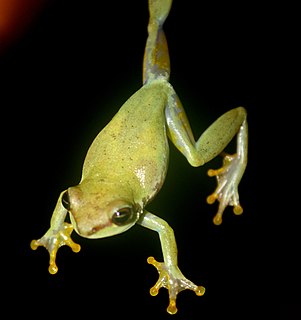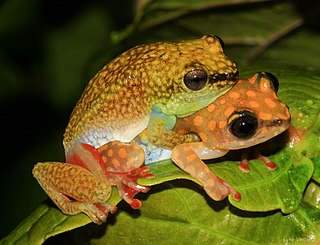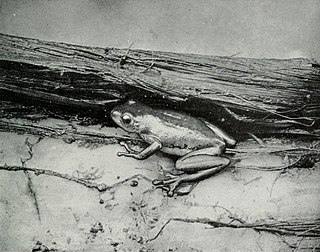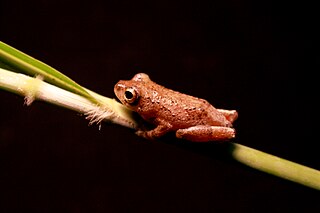Hyperolius bolifambae is a species of frog in the family Hyperoliidae. It is known from southeastern Nigeria, southern Cameroon, and southwestern Central African Republic, with an isolated record in northeastern Democratic Republic of the Congo ; the latter record may be considered doubtful. It likely has a broader range towards south and east than currently documented, and the AmphibiaWeb includes Gabon and the Republic of the Congo in the distribution.

Hyperolius concolor, also known as the variable reed frog or Hallowell's sedge frog, is a species of frog in the family Hyperoliidae. It occurs in West and Middle Africa.
Hyperolius discodactylus is a species of frogs in the family Hyperoliidae. It occurs in the montane areas of eastern Democratic Republic of the Congo and western Uganda, Rwanda, and Burundi. It is also known as the Albertine Rift reed frog, highland reed frog, or disc-fingered reed frog.

Hyperolius fusciventris is a species of frog in the family Hyperoliidae. It occurs in West and Middle Africa between Sierra Leone in the west and western Cameroon in the east. Common name lime reed frog has been coined for this species.

Hyperolius guttulatus is a species of frog in the family Hyperoliidae. It occurs in West and Middle Africa between Sierra Leone in the west and Gabon in the east/south. Common name dotted reed frog has been coined for this species.
Hyperolius igbettensis is a species of frog in the family Hyperoliidae. It is found in West Africa from Guinea eastward to Liberia, Ivory Coast, Ghana, Togo and Benin, Nigeria, and into Central Africa at least to Cameroon but likely further east to the Central African Republic and southwestern Chad; the eastern border of distribution of this species relative to other members in the Hyperolius nasutus complex is unclear. Common name Igbetti long reed frog has been coined for it. The type locality is near Igbetti, a village in Oyo State, Nigeria.

Hyperolius kihangensis, also known as the Kihanga reed frog or volcano reed frog, is a species of frogs in the family Hyperoliidae. It is endemic to the Udzungwa Mountains in south-central Tanzania.
Hyperolius occidentalis is a species of frog in the family Hyperoliidae. Its common name is western reed frog. It is found in the coastal lowlands of westernmost West Africa in Senegal, the Gambia, Guinea-Bissau, Guinea, and Sierra Leone.

Hyperolius picturatus is a species of frog in the family Hyperoliidae. It is found in northern and eastern Sierra Leone, southern Guinea, Liberia, Ivory Coast, and Ghana; its range might extend to Togo. Common names coined for this species are Tanzania reed frog and variable montane sedge frog.
Hyperolius pseudargus, also known as the Mette's reed frog, is a species of frogs in the family Hyperoliidae. It is endemic to south-central Tanzania and occurs in the Udzungwa Mountains and south to Njombe in the Southern Highlands. Male Hyperolius pseudargus greatly resemble Hyperolius argus but have less webbing between the toes and the male advertisement call is different. The vernacular name refers to Mette Westergaard, Danish biologist who collected the holotype and is the junior describer of this species.
Hyperolius sylvaticus is a species of frog in the family Hyperoliidae. It is found in southern Ivory Coast, Ghana, Togo, Nigeria, and western Cameroon, with a gap in Benin. It is also likely to occur in Liberia. Common name Bobiri reed frog has been coined for this species.
Hyperolius torrentis is a species of frog in the family Hyperoliidae. It is known from the Akwapim-Togo Ranges along the border between Ghana and Togo as well as from northeastern Benin. Common name Ukami reed frog has been coined for this species.

Hyperolius tuberculatus is a species of frog in the family Hyperoliidae. Its common name is rainforest reed frog. It ranges from the southeastern Nigeria to the Central Africa in Cameroon, western Central African Republic, Equatorial Guinea, Gabon, Republic of the Congo, and Democratic Republic of the Congo. It is also likely to occur in the Cabinda enclave of Angola.
Hyperolius wermuthi is a species of frog in the family Hyperoliidae. It is found in Ivory Coast, southern Guinea, and Liberia. The correct name for this species is likely Hyperolius soror. It is so similar to Hyperolius fusciventris that it has likely been overlooked elsewhere in West Africa. Common name Wermuth's reed frog has been coined for this species.
Kassina cassinoides, also known as large running frog or silver running frog, is a species of frog in the family Hyperoliidae. It is found in Cameroon and—disjunctly—in West Africa, specifically in in Senegal, the Gambia, Mali, Burkina Faso, Ivory Coast, Ghana, Togo, and Benin. It might occur more broadly, and presumably occurs in Guinea, Guinea-Bissau, Niger, Nigeria, and Mauritania.
The savannah forest tree frog or ground tree frog, Leptopelis bufonides, is a species of frog in the family Arthroleptidae. It occurs in West and Middle Africa. The relationship of this species with Leptopelis bocagei is not fully settled.
Aubria subsigillata, commonly known as the brown ball frog or the West African brown frog, is a species of frog belonging to the family Pyxicephalidae. It has a discontinuous distribution from southern Guinea through Liberia and Ivory Coast, and from Nigeria to southern Cameroon, and Equatorial Guinea to Gabon. However, the species delimitation differs between sources, and the International Union for Conservation of Nature has adopted a narrower view where this species only occurs in Cameroon and southward.
Ptychadena tournieri is a species of frog in the family Ptychadenidae. It is a widespread species in West Africa and found in Senegal, Gambia, Guinea-Bissau, Guinea, Sierra Leone, Liberia, and Ivory Coast, as well as in Togo and Benin; it is assumed to occur in Ghana and southeastern Burkina Faso, although it has not been recorded there. On the other hand, some records may refer to other species; the Amphibian Species of the World excludes Gambia and Togo from the distribution. Common names Liberia grassland frog and Tournier's rocket frog are sometimes used.
Ptychadena trinodis is a species of frog in the family Ptychadenidae. Its common name is Dakar grassland frog. It is widely distributed in West and Middle Africa, and following the International Union for Conservation of Nature (IUCN), occurs in Benin, Cameroon, Central African Republic, Chad, Democratic Republic of the Congo, Gambia, Ghana, Guinea, Ivory Coast, Mali, Mauritania, Nigeria, Senegal, and Togo. Further, records are missing from Guinea-Bissau, Burkina Faso, Niger, South Sudan, and Sudan, but it is presumed to be present in these countries too.






